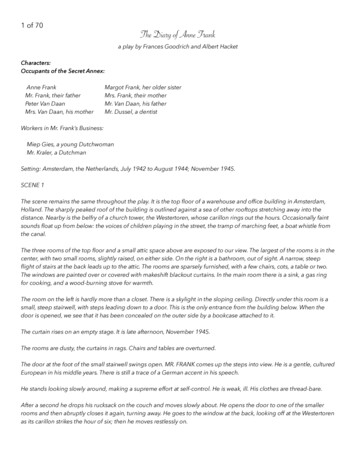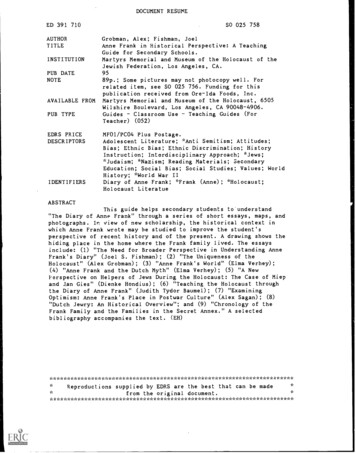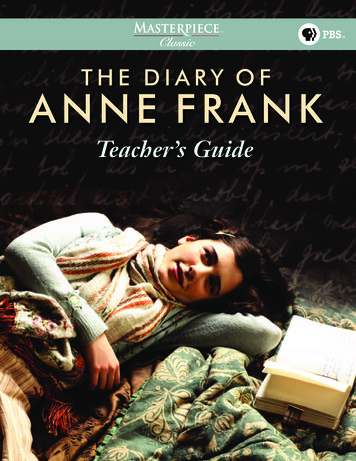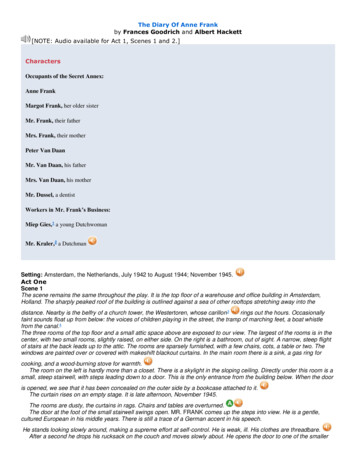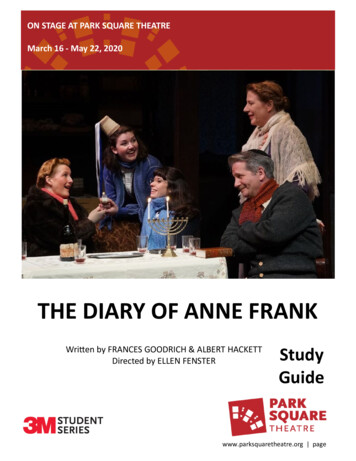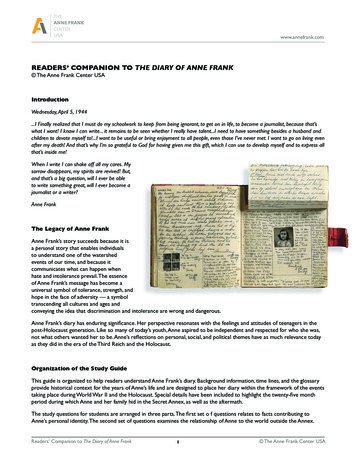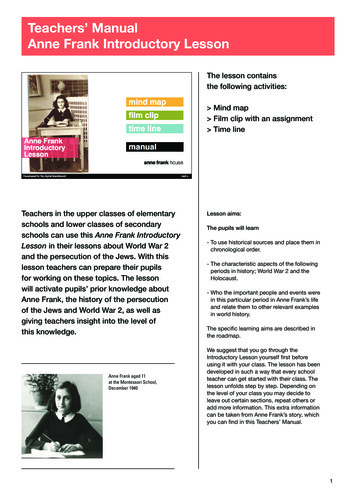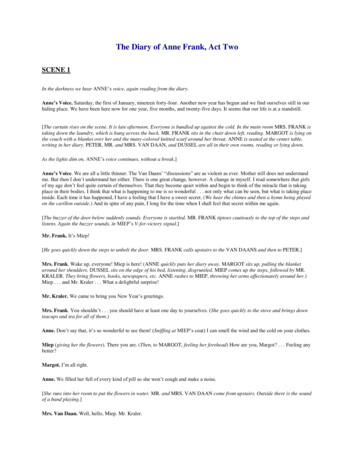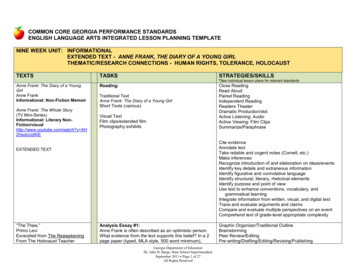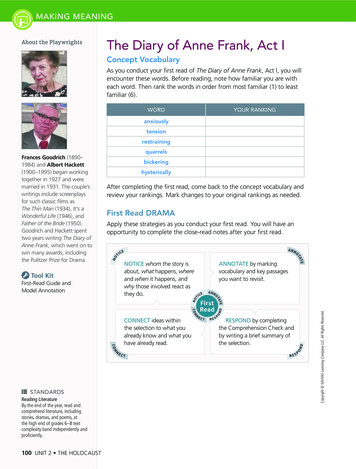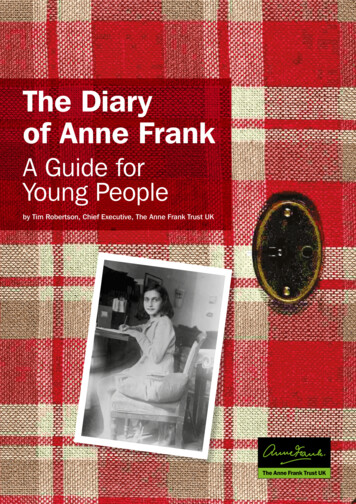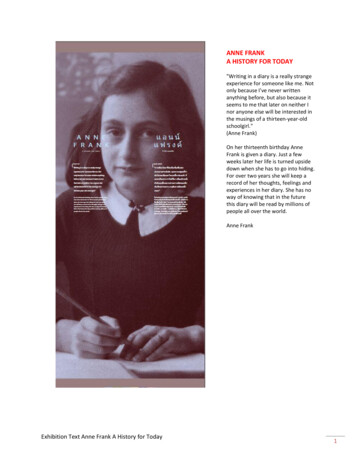
Transcription
ANNE FRANKA HISTORY FOR TODAY"Writing in a diary is a really strangeexperience for someone like me. Notonly because I've never writtenanything before, but also because itseems to me that later on neither Inor anyone else will be interested inthe musings of a thirteen-year-oldschoolgirl."(Anne Frank)On her thirteenth birthday AnneFrank is given a diary. Just a fewweeks later her life is turned upsidedown when she has to go into hiding.For over two years she will keep arecord of her thoughts, feelings andexperiences in her diary. She has noway of knowing that in the futurethis diary will be read by millions ofpeople all over the world.Anne FrankExhibition Text Anne Frank A History for Today1
"I was born on 12 June 1929.""My father, the most adorable fatherI've ever seen, didn't marry mymother until he was thirty-six andshe was twenty-five. My sisterMargot was born in Frankfurt amMain in Germany in 1926. I was bornon 12 June 1929."(Anne Frank)Anne Frank is the second daughter ofOtto Frank and Edith FrankHolländer. The Frank and Holländerfamilies have lived in Germany forgenerations. The Frank family areliberal Jews. They feel a bond withthe Jewish faith, but they are notstrictly observant.In 1930 around 1% of the Germanpopulation, more than half a millionpeople, are Jewish.1. Anne's parents' wedding, 12 May1925.2. Anne's father (left) and her uncleRobert as German officers during theFirst World War (1914 - 1918).3. Anne's grandmother Frank as anurse in a military hospital duringthe First World War.Exhibition Text Anne Frank A History for Today2
Crisis in GermanyThe First World War ends in 1918with Germany's defeat. The Treaty ofVersailles drawn up at the end of thewar imposes harsh reparations onGermany. Millions of people losetheir jobs and are thrown intodesperate poverty. Inflation is out ofcontrol: by 1923 the currency ispractically worthless. Many Germansfeel bitterly resentful. In 1929 theworld is plunged into economiccrisis, and Germany is especially hardhit. The NSDAP (National SocialistGerman Workers Party), a smallextremist nationalist political partyled by Adolf Hitler, blames the Jewsfor all of Germany's and the world'sproblems. Hitler also claims to havethe solution to the problems ofunemployment and poverty.1. A demonstration against theTreaty of Versailles at the Reichstagin Berlin in 1932.2. Collecting money for povertystricken children in Berlin, 1920.3. Children playing with a pile ofworthless banknotes, 1923.4. Hitler on the day of the annualparty rally in Nuremberg, 1927. Herepeatedly claims that the Jews areto blame for Germany’s problems.5. Hitler attracts a growing following.In 1930, 18.3% of Germans vote forthe Nazi party (NSDAP).Exhibition Text Anne Frank A History for Today3
"I lived in Frankfurt until I wasfour." (Anne Frank)"As early as 1932, groups ofStormtrooper (Brownshirts) camemarching by singing: 'When Jewishblood splatters off the knife'. . . Iimmediately discussed it with mywife: 'How can we leave here?' ".(Otto Frank)Otto and Edith are deeply worriedabout the future. The Nazis aregrowing in strength and brutality.What is more, the economic crisismeans that things are going frombad to worse at the bank where Ottoworks. Otto and Edith want to getaway, and wonder if there is anothercountry where they could start anew life. Margot and Anne knownothing of their parents' worries.1. Anne, Margot and their father,1930.2. In October 1933, Anne and Margotstayed with their grandmotherHolländer in Aachen (Germany), nearthe Dutch border.3. Anne, July 1933.4. Margot Frank in 1929. She wasthree years old when her sister Annewas born.Exhibition Text Anne Frank A History for Today4
Hitler wins the electionsBy 1932, almost 6 million Germansare unemployed. More and moreGermans are attracted to radicalanti-democratic parties. BothCommunists and National Socialistsclaim to have the one and onlysolution to all of society's problems.Political differences are often foughtout on the streets. The NSDAPexploit this violence to their ownadvantage, and at the November1932 elections they become thelargest party in parliament, with33.1% of the vote.1. 'Hitler: Our Last Hope'NSDAP election poster, 1932.2. A poor neighbourhood in Berlin in1932. Communists and NationalSocialists live in the same street. Onthe wall is written: "Our children arewasting away here".3. Hitler is shown ringed by avidadmirers in this photo from 1932.4. The Nazis still have manyopponents in 1932. This is an antiNSDAP demonstration.5. Unemployed people lining upoutside the employment office inHannover. The words on the fenceread: ‘Vote for Hitler’.Exhibition Text Anne Frank A History for Today5
" the world around mecollapsed "" the world around me collapsed. . .I had to face the consequences andthough this did hurt me deeply Irealized that Germany was not theworld and I left forever."(Otto Frank)On 30 January 1933 Hitler becomesChancellor of Germany.The new rulers soon make their trueintentions clear. The first anti-Jewishlaws are introduced, and thepersecution of the Jews in Germanybegins in earnest.For Otto Frank, the time has come toleave Germany. He tries to find workin the Netherlands, where he hasbusiness contacts. He succeeds in hissearch, and the Frank familyemigrates to Amsterdam.1. While Otto makes preparations forthe emigration, Anne and Margotstay with their mother at theirgrandmother Holländer's house inAachen (Germany).2. Adolf Hitler becomes Chancelloron 30 January 1933.3. Nazi violence against the Jews iswidely reported in the internationalmedia, but the Nazis claim this isnothing but Jewish propaganda. On 1April 1933 they begin a boycott ofJewish lawyers, doctors, shops anddepartment stores.4. Anne, Edith and Margot Frank, 10March 1933. Tietz department storein Frankfurt (Germany) had aPhotoweigh photo booth where youcould weigh yourself and have yourpassport photo taken.He repeatedlyclaims that the Jews are to blame forGermany’s problems.Exhibition Text Anne Frank A History for Today6
DictatorshipThe NSDAP does not only terrorisethe Jews, but also its politicalopponents. Communists and SocialDemocrats in particular arepersecuted and confined toconcentration camps. Certain typesof art, literature and music arebanned, and books are burned in thestreets. Many writers, artists andscientists flee abroad. Democracy isabolished. Jewish civil servants andteachers are dismissed.1. An NSDAP torchlight marchthrough Berlin, 1933.2. On 23 March 1933, Parliamentvotes to allow Hitler to rule withoutdemocratic consent. Only the SocialDemocrats, those who have notalready been arrested or fled, voteagainst. The Communist Party hasalready been banned.3. A public book-burning in May1933. The authors, many of themJewish, are branded 'un-German'.4. 'Führer, we follow you! Everyonesays Yes!'In mid-1933 all political parties arebanned. The only party permitted isthe NSDAP.5. Political opponents are roundedup, March 1933.Exhibition Text Anne Frank A History for Today7
"To Holland""Because we're Jewish, my fatheremigrated to Holland in 1933, whenhe became the Managing Director ofthe Dutch Opekta Company, whichmanufactures products used inmaking jam." (Anne Frank)Otto Frank begins to build up hisbusiness selling 'Opekta', a gellingagent for jam. The Frank family moveinto a house on the Merwedepleinsquare, part of a new housingdevelopment in Amsterdam. Moreand more refugees from Germanycome to live in the neighbourhood.Anne and Margot go to a local schooland quickly learn Dutch.1. Anne at school, 1935.2. Otto Frank and his secretary MiepGies, who began working for him in1933.3. Anne with her friends EvaGoldberg (on the left) and SanneLedermann (in the middle) at theMerwerdeplein (Amsterdam), 1936.4. Margot and Anne with theirfriends Ellen Weinberger (secondfrom the left) and Gabrielle Kahn (onthe right). The photo was taken atthe home of the Kahn family inAmsterdam, 1934.Exhibition Text Anne Frank A History for Today8
The Nazification of GermanyIn Germany, 'law and order' havereturned, and the economy is on theupturn. The Nazis take control of theupbringing and education of youngpeople, with the aim of turning theminto 'good Nazis'. The media (radio,newspapers and film) only reflectNazi ideology.There is great enthusiasm for Hitlerand his party. There are someopponents too, but most of themremain silent for fear of violence andimprisonment. A variety of antiJewish measures are introduced.There is little resistance.1. Rigidly organized mass ralliesmake a big impression. Ademonstration against the Treaty ofVersailles at the Reichstag in Berlin in1932.2. The unemployed are put to workon the construction of highways,government buildings and civilprojects. Hitler also begins to buildup a weapons industry and a largearmy. Unemployment fallsdramatically.3. Young and old alike are full ofenthusiasm for the Nazis.4. 'Youth Serves the Führer''All ten-year-olds in the Hitler Youth'5. The Nazis want complete controlof young people's upbringing. Boys'activities take on a military flavour,while girls are prepared for theirroles as housewives and mothers.Exhibition Text Anne Frank A History for Today9
"There goes Anne, Hanne andSanne""Hanneli and Sanne used to be mytwo best friends. People who saw ustogether used to say, 'There goesAnne, Hanne and Sanne.'" (AnneFrank)Hannah Goslar and Sanne Ledermanare both Jewish, and both of themcome from Berlin. The stream ofrefugees keeps growing, and moreand more people who have fledGermany come to live in Anne'sneighbourhood. Around half of thechildren in Anne's class are Jewish.1. Anne with her friends in a sandpit,1937. Hannah is on the left, Sanneon the right.2. Anne, 1935, 1936, 1937.Margot, 1935, 1936, 1937.3. Anne at a summer camp for citychildren in Laren near Amsterdam in1937.4. There are many Jewish children inAnne's class, most of them fromGermany.Exhibition Text Anne Frank A History for Today10
Race LawsIn 1935, 'race laws' are introduced. OnlyGermans with so-called 'German blood'can be full citizens from now on. Allothers have fewer rights.Hitler's ideal is a 'racially pure' Germanpeople. According to him, the German'Aryan race' is superior to all others. TheNazis see the Jews not only as inferior,but also as dangerous. They harbour thedelusion that 'the Jews' are engaged in aworldwide conspiracy to destroy the socalled 'Aryan race'.Jewish people face mounting restrictions,and all to one purpose: to isolate theJews from the non-Jewish population.1. The Nazis believe that people can bedivided into 'races', and that their own'Aryan race' is superior. Here, a child isbeing examined for 'racial traits'.2. Schoolchildren are given lessons in‘racial studies’.3. Hitler issues an order to kill disabledpeople in order to prevent the'weakening of the race'. Some 80,000disabled people, this girl among them,are murdered.4. The Nazis also consider black people'inferior'. There are around 20,000 blackpeople living in Germany in the 1930's. In1937, 385 black children are secretlysterilised.5. Thirty-nine Roma ('Gypsy') children arebrought to the 'St. Josefspflege' clinic inthe German town of Mulfingen for socalled 'racial studies'. In 1944 thechildren are sent to Auschwitz, wheremost of them are killed in the gaschambers, while others are forced toundergo medical experiments. Only foursurviveExhibition Text Anne Frank A History for Today11
"Our lives were not without anxiety. .""Our lives were not without anxiety,since our relatives in Germany weresuffering under Hitler's anti-Jewishlaws. After the pogroms in 1938 mytwo uncles (my mother's brothers)fled Germany, finding safe refuge inNorth America. My elderlygrandmother came to live with us.She was seventy-three years old atthe time." (Anne Frank)Otto and Edith Frank get to knowother German refugees. They meetHermann and Auguste van Pels andtheir son Peter, and Fritz Pfeffer, allof whom will later go into hidingwith them. The Van Pels family fledfrom Osnabrück in 1937, andHermann van Pels became a partnerin Otto Frank's business. Like Anne'suncles, Fritz Pfeffer left Germanyfollowing 'Kristallnacht'.1. Anne (second from the left) in theVondelpark in Amsterdam, in thewinter of 1940/1941. Figure-skatingwas her great passion. This is theonly photo of Anne skating that hassurvived. A demonstration againstthe Treaty of Versailles at theReichstag in Berlin in 1932.2. Anne's Grandmother Holländerleaves for Amsterdam in March 1939and comes to live with the Frankfamily. She dies in 1942.3. Peter van Pels (centre) withfriends at the Jewish Boy Scouts inOsnabrück, Germany, in 1936.4. Fritz Pfeffer with his non-Jewishfiancée Charlotte Kaletta.In Germany, marriages betweenJews and non-Jews have been illegalsince 1935. They cannot marry in theNetherlands either, because itrespects German law.Exhibition Text Anne Frank A History for Today12
The persecution of the JewsbeginsOn the night of 9-10 November1938 (the so-called 'Kristallnacht',or Night of Broken Glass) theNazis organise a series of attacksagainst the Jews. In this one nightof violence 177 synagogues aredestroyed, 7500 shops wreckedand 236 Jews murdered. Around30,000 are arrested and sent toconcentration camps.Only now does the true scale ofthe danger they are in becomeapparent, and many Jews decideto flee Germany, but more andmore countries are closing theirborders to refugees.1. Jewish refugees on board the'St. Louis' in the harbour atAntwerp, Belgium, 17 June 1939.2. Passers-by at a vandalised shopon the Potsdamer Strasse inBerlin on the morning of 10November 1938. The term'Kristallnacht' refers to thebroken glass that litters thestreets.3. Jews in Oldenburg, Germany,under arrest after 'Kristallnacht'.4. Hitler on the day of the annualparty rally in Nuremberg, 1927.He repeatedly claims that theJews are to blame for Germany’sproblems.5. A Frankfurt synagogue inflames during 'Kristallnacht', 9-10November 1938.Exhibition Text Anne Frank A History for Today13
War!On 1 September 1939 the Germanarmy invades Poland. Large areas arecleared by the army to make way forsettlement by German colonists.Many prominent Poles are killed.Little news of the atrocities beingcarried out in Poland filters throughto Western Europe.In May 1940 the Netherlands,Belgium and France are also invadedby the German army. The Nazis seethe non-Jewish people of thesecountries, in contrast to the Poles, asmembers of the same 'race', and donot commit atrocities on the scale ofthose in Poland.The registration of Jews begins in thefirst year of the occupation of theNetherlands.1. In September 1939 the SecondWorld War breaks out.2. Behind the front line in Poland thecampaign of terror against the Jewsbegins immediately. Jews arepublicly humiliated and beaten up inthe streets. The occupying forcescarry out pogroms in whichthousands of Jews are killed.3. The arrival of the German army inAmsterdam, near to Otto Frank'sbusiness, 16 May 1940.4. At first the Nazis attempt to winover the Dutch people to their ideas,but with little success. Only a smallproportion of the populationcollaborate with the occupiers.5. Warsaw, 14 September 1939.Polish children look anxiously to thesky as German aircraft attack thecity. In 1930, 18.3% of Germans votefor the Nazi party (NSDAP).Exhibition Text Anne Frank A History for Today14
" the trouble started for the Jews.""After May 1940 the good timeswere few and far between: firstthere was the war, then thecapitulation and then the arrival ofthe Germans, which is when thetrouble started for the Jews." (AnneFrank)The Second World War breaks out afew months after Anne's tenthbirthday. Otto and Edith hope thatthe Netherlands will stay out of thewar, but on 10 May 1940 theGerman army invades. The Nazisquickly begin the process ofidentifying who is Jewish and who isnot. After a year, the names andaddresses of the majority of Jews inthe Netherlands are known to theoccupiers.1. The Frank family on theMerwedeplein square in Amsterdam.2. Anne (third from the right), herfather (third from the left) and otherguests at the wedding of Jan Giesand Miep Santrouschitz inAmsterdam on 16 July 1941.3. Dutch Nazis marching through theJewish quarter of Amsterdam. Theyoften provoke violence with theJews.4. Hitler on the day of the annualparty rally in Nuremberg, 1927. Herepeatedly claims that the Jews areto blame for Germany’s problems.Exhibition Text Anne Frank A History for Today15
IsolationOnce the names and addresses ofthe Jews are known, their isolationcan begin. The Nazis introduce a fastgrowing array of anti-Jewishmeasures, with the effect that manynon-Jews no longer dare to associatewith Jews, or vice versa.1. In Germany and in most of theoccupied territories Jews are forcedto wear a yellow star.2. The first major open conflictbetween the occupying forces andthe Dutch people comes in February1941, after 427 Jewish men arerounded up and deported to theMauthausen concentration camp.The people of Amsterdam and thesurrounding area go on strike inprotest against the persecution ofthe Jews, but the strike is violentlybroken up after two days.3. By order of the occupiers, signsappear with the message 'Jews NotAllowed' or 'Jews Not WelcomeHere'.4. In Eastern Europe special armyunits, 'Einsatzgruppen', have the taskof killing as many Jews, 'Gypsies', andpartisans as possible. In just one yearan estimated one million men,women and children are murdered.5. In the Netherlands, from 3 May1942, all Jewish children over sixyears old have to wear a yellow star.Exhibition Text Anne Frank A History for Today16
" a series of anti-Jewish decrees ""Our freedom was severely restricted bya series of anti-Jewish decrees: Jewswere required to wear a yellow star;Jews were required to turn in theirbicycles; Jews were forbidden to usetrams; Jews were forbidden to ride incars, even their own; Jews were requiredto do their shopping between 3.00 and5.00 p.m.; Jews were required tofrequent only Jewish-owned barbershopsand beauty salons; Jews were forbiddento be out on the streets between 8.00p.m. and 6.00 a.m." (Anne Frank)Jewish children now have to go toseparate Jewish schools, in Anne andMargot's case the Jewish Lyceum.Because Jews are no longer allowed tohave their own businesses, Otto Franknames Johannes Kleiman as companydirector, although Otto remains activebehind the scenes. The company is alsogiven a new name, Gies & Co, after JanGies, the husband of Miep Gies.1. Anne at the Montessori school inAmsterdam, 1941.A secret planBehind all the anti-Jewish measures liesHitler's secret plan: all 11 million Jews inEurope are to be killed. This decision isworked out in detail by high-ranking Naziofficials at a top-secret meeting at a villain Berlin in January 1942: the so-called'Wannsee Conference'.The Jews must suspect nothing. They aretold they are being sent to ‘labourcamps’. In reality they are transported tospecially constructed exterminationcamps, most of them in Poland, whichhave been specifically designed for therapid and ‘efficient’ killing and cremationof as many human beings as possible.Large-scale deportations to these campsbegin in the summer of 1942. Most ofthe Jews who are sent there are killedimmediately on their arrival. Theremainder are forced into grueling slavelabour until they die of2. At the Wannsee Conference acalculation is made of the number ofJews living in Europe.Exhibition Text Anne Frank A History for Today17
"I hope I will be able to confideeverything to you. . .""I hope I will be able to confideeverything to you, as I have neverbeen able to confide in anyone, and Ihope you will be a great source ofcomfort and support." (Anne Frank)Anne writes these words on the firstpage of the diary which she is givenfor her thirteenth birthday on 12June 1942. She writes the diary inthe form of letters to her imaginaryfriend Kitty about school, her friendsand her life up to that point. Shecannot foresee that three weekslater her life will change completely.1. Anne's diary2. Anne Frank 1935-19423. Anne’s diary. On some pages shewould paste passport photos ofherself and comment on them.4. Anne switches between two kindsof handwriting in her diary.Sometimes she writes in blockletters, but she often also uses aflowing, slanted script.Exhibition Text Anne Frank A History for Today18
"I was stunned. A call-up. . ."“At three o’ clock. . . the doorbellrang. I didn’t hear it, since I was outon the balcony, lazily reading in thesun. A little while later Margotappeared in the kitchen doorwaylooking very agitated. ‘Father hasreceived a call-up notice from theSS’, she whispered. . . I was stunned.A call-up: everyone knows what thatmeans. Visions of concentrationcamps and lonely cells raced throughmy head.” (Anne Frank)Three weeks after Anne's birthday,on 5 July 1942, a call-up noticearrives for Margot to report to theauthorities. She is to be sent to a'labour camp' in Germany. The callup does not come as a completesurprise to Anne's parents: sinceearly 1942 Otto Frank has alreadybeen making preparations to go intohiding in the '', a part of his officeson the Prinsengracht. Only his mosttrusted employees know of theseplans. The decision is made to gointo hiding immediately.1. Margot Frank at the JewishLyceum, December 1941.2. A passport photo of Anne, May1942. Probably the last photo thatwas taken of her.3. A call-up notice, with a list of theitems the deportees must take withthem.4. The Frank family decide to go intohiding the very next day. Miep Giesand other helpers come the sameevening to bring as many items aspossible to the hiding place. Jews areto blame for Germany’s problems.Exhibition Text Anne Frank A History for Today19
" an ideal place to hide in.""The Annexe is an ideal place to hidein. It may be damp and lopsided, butthere's probably not a morecomfortable hiding place in all ofAmsterdam. No, in all of Holland."(Anne Frank)The hiding place is in an empty partof Otto Frank's offices. Later, the VanPels family and Fritz Pfeffer join theFranks there. For the next two yearsthese eight people remain in the ,cut off from the outside world. It is atime full of fear and tension, but alsoof arguments or stifling boredom.Four of Otto Frank's trustedemployees keep the eight people inhiding supplied with food, clothesand books.1. The building on the Prinsengracht.The hiding place, the ‘SecretAnnexe’, is at the rear.2. The inhabitantsOtto FrankEdith FrankMargot FrankAnne FrankHermann van PelsAuguste van PelsPeter van PelsFritz Pfeffer3. The helpers.Miep GiesJohannes KleimanVictor KuglerBep VoskuijlExhibition Text Anne Frank A History for Today20
". . . I'm terrified our hiding place will bediscovered and that we'll be shot.""Not being able to go outside upsets memore than I can say, and I'm terrified ourhiding place will be discovered and thatwe'll be shot." (Anne Frank)During the day, while people are at workin the building, the inhabitants have toremain very quiet. The warehouseemployees have no idea they are there.Because the waste pipe from the toiletruns alongside the warehouse, it must beflushed as infrequently as possible. Allthe windows are blacked out withblankets so that the neighbours cannotsee in, and the door which leads to the ishidden behind a hinged bookcase. Duringthese long, silent hours Anne reads herschoolbooks, plays games with theothers and writes in her diary.1. The building at Prinsengracht 263. Atthe rear, shown here shaded in red, isthe hiding place in the Secret Annexe.The Secret Annexe1. Bookcase.2. Anne and Fritz Pfeffer's room.3. Otto, Edith and Margot's room.4. Hermann and Auguste van Pels'sroom, also used as dining room.5. Peter van Pels's room.6. Bathroom and toilet.7. Storage attic.The business premises8. Warehouse.9. Office where the helpers work.10. Office storeroom.2. A hinged bookcase conceals theentrance to the .3. Anne and Fritz Pfeffer's room. Annehas decorated the walls with photos.Some years ago, for the making of a film,the was temporarily fitted out as it musthave looked while the people were inhiding.Exhibition Text Anne Frank A History for Today21
"All are marched to their death""It's impossible to escape theirclutches unless you go into hiding.No one is spared. The sick, theelderly, children, babies andpregnant women - all are marched totheir death." (Anne Frank)The inhabitants receive news fromthe outside world that Jews arebeing hunted down. They feelanxious and powerless. On the radiothey hear about gassings. Annesometimes finds the pressureunbearable. She is often rebelliousand rude to the others, andfrequently gloomy and depressed.There are many things which shefeels she cannot talk about properlywith the others. Her diary is her bestfriend.1. Almost every day Anne writesabout her thoughts, feelings andexperiences. This diary is already fullafter a few months. She continues towrite in notebooks which she is givenby Bep.2. The deportation of AmsterdamJews, summer 1943. Anne gets tohear that friends and classmateshave been arrested. At first thehelpers still pass on news of what ishappening in the outside world tothe Secret Annexe inhabitants, butlater they stop.3. The helpers try to keep up thespirits of the inhabitants . They bringthem food, books, newspapers andmagazines. Anne especially likes themagazine 'Cinema and Theatre'.4. Otto, Edith and Margot's room.Anne usually spends her days in thisroom, because the small room isoccupied by Fritz Pfeffer.Exhibition Text Anne Frank A History for Today22
" will I ever become a journalist ora writer?"" will I ever become a journalist or awriter? I hope so, oh, I hope so verymuch, because writing allows me torecord everything, all my thoughts,ideals and fantasies." (Anne Frank)Anne has discovered a talent and alove for writing. On 28 March 1944she hears in a radio broadcast fromLondon that the Dutch governmentwill be making a collection ofpeople's diaries after the war. Shedecides to re-write her diary in thehope that it will later be published asa book. She has even thought of atitle: ‘The ’.Hopes of liberation are raised in theby the news that the Allies havelanded in Normandy and areadvancing.1. Anne begins to re-write her diaryon loose sheets of paper.2. Anne also writes short stories, andsometimes reads them to the others.3. Anne feels she is falling in lovewith Peter van Pels.4. Anne and Peter spend hourstogether in Peter's room.Exhibition Text Anne Frank A History for Today23
"I hear the approaching thunder. . .""It's difficult in times like these:ideals, dreams and cherished hopesrise within us, only to be crushed bygrim reality. It's a wonder I haven'tabandoned all my ideals, they seemso absurd and impractical. Yet I clingto them because I still believe, inspite of everything, that people aretruly good at heart. It's utterlyimpossible for me to build my life ona foundation of chaos, suffering anddeath. I see the world being slowlytransformed into a wilderness, I hearthe approaching thunder that, oneday, will destroy us too, I feel thesuffering of millions. And yet, when Ilook up at the sky, I somehow feelthat everything will change for thebetter, that this cruelty too will end,that peace and tranquility will returnonce more. In the meantime, I musthold on to my ideals. Perhaps theday will come when I'll be able torealise them!" (Anne Frank) [15 July1944]On 1 August 1944 Anne writes thefinal entry in her diary. Three dayslater, on 4 August 1944, the momentthat everyone in the has beendreading arrives.1. Anne often spends time alone inthe attic, struggling to come to termswith her own feelings and events inthe world around her.Exhibition Text Anne Frank A History for Today24
The betrayalOn Friday 4 August 1944, a car pullsup in front of the building on thePrinsengracht. A group of armedmen step out and enter thewarehouse. Someone has called thepolice to say there are Jews here.Karl Josef Silberbauer, an AustrianNazi, is in command. The others areDutch police officers. The inhabitantsare taken completely by surprise.They are given just enough time topack their bags. Silberbauer grabs abriefcase and shakes out thecontents so he can use it to takeaway money and jewelry. Anne'sdiary papers fall out onto the floor.Then Anne and the others are takenaway to the local prison.1. Karl Josef Silberbauer, the SSofficer who led the arrest. Nineteenyears later, in 1963, he is trackeddown in Vienna, where he is workingas a police officer. He is suspended,but later reinstated after making astatement that he does not knowwho the informant was. To this day itremains unclear who betrayed theinhabitants.2. Anne and the others are firstbrought to Gestapo headquarters.Four days later they are taken bytrain to the transit camp atWesterbork in the Dutch province ofDrenthe.Exhibition Text Anne Frank A History for Today25
" we knew what was happening""We were together again, and had beengiven a little food for the journey. In ourhearts, of course, we were alreadyanticipating the possibility that we mightnot remain in Westerbork to the end. Weknew about deportation to Poland, afterall. And we also knew what washappening in Auschwitz, Treblinka andMaidenek. But then, were not theRussians already deep in Poland? Thewar was so far advanced that we couldbegin to place a little hope in luck. As werode toward Westerbork we were hopingthat our luck would hold. (Otto Frank)Thousands of people are being held inWesterbork. The inhabitants are put inspecial punishment blocks, because theyhad not voluntarily reported fordeportation. They receive especiallyharsh treatment from their guards, andare forced to carry out hard labour.Trains crammed with Jewish peopleleave regularly for the East. After fourweeks, Anne and the others from the arealso taken away, on the last train to leaveWesterbork for Auschwitz.1. Nearly all of the Jews captured in theNetherlands are first taken to theWesterbork transit camp.2. Anne Frank's record card fromWesterbork.3. The train leaves on 3 September 1944,with 1019 people on boar
Exhibition Text Anne Frank A History for Today 2 "I was born on 12 June 1929." "My father, the most adorable father I've ever seen, didn't marry my mother until he was thirty-six and she was twenty-five. My sister Margot was born in Frankfurt am Main in Germany in 1926. I was born on 12 June 1929." (Anne Frank
